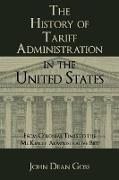- Start
- The History of Tariff Administration in the United States
The History of Tariff Administration in the United States
Angebote / Angebote:
A Comprehensive History of the Tariff System in the United StatesGoss traces the tariff system through three avatars that often existed simultaneously: protective, preventive and punitive. From an ineffective colonial system that allowed importers to avoid payment through extended credit arrangements, to a somewhat less troubled system that demanded immediate cash payments in the early 1840s, to a punitive system designed to stymie smugglers during the Civil War, the collection of tariff duties was always problematic. This problem was enhanced in the wake of industrialization and protectionism when direct taxes began to supplant indirect taxation as the major source of government finance. Reviewing the history of American tariff regulation, Goss discerns a gradual process towards "more stringent supervision, regulation and control" (88). Originally published in the series Studies in History, Economics and Public Law edited by the Political Science Faculty of Columbia University.John Dean Goss (1869-?) served as a judge in Wisconsin. He later moved to Oregon, where he practiced law.Contents IntroductionCHAPTER I. The Colonial Period 1. Virginia customs administration 2. Massachusetts customs administration 3. New York customs administration CHAPTER II. The National Tariff Administration of the Eighteenth Century1. Customs officers 2. Entry of goods and collection of duties 3. System established by act of 1799 CHAPTER III. The Development of the System Established by the Act of 1799 up to the Civil War 1. Prevention of undervaluation 2. The auction system 3. Appraisement reforms of 1830 4. Payment of duties in cash 5. The "similitude section" and the warehouse system 6. The administrative remedy by appeal to the Secretary of the Treasury CHAPTER IV. Tariff Administration from the Civil War to 18901. Attack on the warehouse system 2. Triplicate invoices 3. Dutiable value 4. Appraisement at the port of New York5. Transportation in bond 6. Special agents and general orders 7. Searches and seizures 8. Compensation of customs officers 9. Repeal of the moieties clause 10. Repeal of discrimination against goods from the far East 11. Dutiable value and similitude section under the act of 1883 12. Classification of sugars under the act of 1883 13. Passengers' baggage CHAPTER V. The McKinley Administrative Bill of 1890 1. General purposes of the late tariff acts 2. Increased stringency of provisions to prevent fraud 3. Remedies against appraisement and classification 4. Abolition of damage allowances 5. Manufacturing in bond and drawbacks 6. Abolition of fees CONCLUSION. General Tendencies of Tariff Administration in the United States
Folgt in ca. 10 Arbeitstagen


